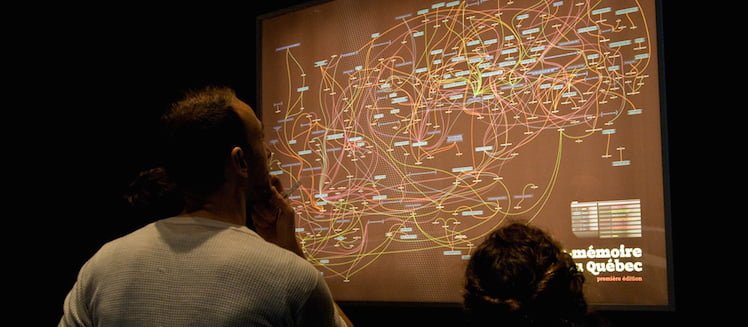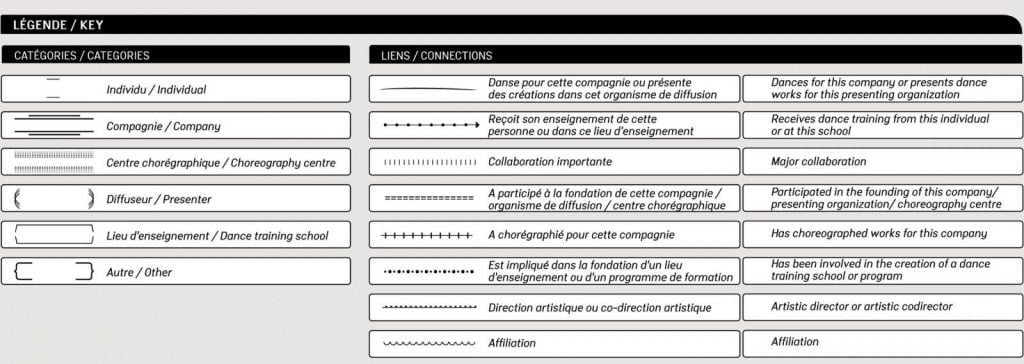Toile-mémoire de la danse au Québec [1895-2000]
“The Toile-mémoire is reminiscent of both a painter’s canvas and a spider web: a system of lines generating a support framework. The term “memory” is understood as an active exercise rather than an asset or finality. The neologism Toile-mémoire (“memory canvas”) describes this new form, whose organic lines suggest movement, shifting territory.”
Catherine Lavoie-Marcus, originator of the Toile-mémoire
How did the Toile-mémoire come into being?
The Toile-mémoire is inextricably linked to the context in which it came into being: The Toile-mémoire was created at the time when the dance community was rallying round the Grands Chantiers de la danse. Launched in 2007, this ambitious consultation and cooperation effort led to the Seconds États généraux de la danse professionnelle du Québec in 2009 (where the initial version of the Toile was unveiled) and the subsequent publication of the Master Plan for Professional Dance in Quebec 2011-2021. Amid this context, it became imperative to lay the groundwork for a history of Québec-based professional dance in the 20th century—which constituted an added effort to enrich the dance community’s identity and spark reflections on its historical lineage. On the strength of this conviction, the RQD launched the project to come up with an historical reconstruction drawing on oral transmissions, with roots in the body itself.
How did its form arise?
To create a work based on memory, to historicize dance, is to attempt to fuse the worlds of movement and words. It was first necessary, based on the information available, to identify the major players who had a role in transmitting dance-related knowledge and skills, including those catalogued by dance historian Iro Valaskakis-Tembeck. Based on 315 entities, the project documented their interrelationships over the decades, bringing them together in a kind of genealogical tree. By connecting these lines on the same diagram, new lines appeared, generating points of intersection, networks and areas of concentration—or, conversely, areas of separation or rupture. The Toile-mémoire is the result of painstaking work in graphic composition and a series of choices: visual, temporal, geographic and stylistic. The resulting form resembles a constellation, constantly animated by a profusion of elements, like a nomadic territory characterized by transformations and exchanges.
What does it represent?
The Toile-mémoire brings together a variety of individuals and companies, as well as training and presentation sites, which are related through historical filiations of transmission, training or artistic collaboration. It is an anthology of stories that shed light on each other. At the forefront, we find the dance figures that allow us to discern, in the background, the aesthetic and stylistic dimensions of the affiliations. Through its focal points, for example, the Toile-mémoire allows us to identify the vectors leading to the major aesthetic families.
How should it be used?
Despite its physical frame and boundaries, the Toile-mémoire has neither a starting point nor end point: it offers, on the contrary, several historical entry points and several layers of interpretation. Like a large weave with multiple strands, and captions indicating the colours, the Toile-mémoire sets in motion a dialogue between past and present, offering numerous histories to discover.
We can see, for example, the migratory movements and groups that resulted in Quebec or, more strikingly, the lack of ties and exchanges between Montreal’s Francophone and Anglophone dance communities, the former developing east of the Main, the other to the west. Clearly visible on the Toile-mémoire, these “two solitudes” are worth examining from socio-historical and disciplinary points of view.
What does it not show?
The Toile-mémoire took on a major challenge: to graphically identify and connect prominent figures of Québec dance. The resulting image, however, does not reveal everything. Several elements extend beyond the “frame” of the canvas and cannot be represented. For example, many artists received their training abroad, but the Toile-mémoire does not show these influences or reveal the scope of the affiliations between dance in Canada, Europe, America, Africa, India, Asia, etc. These contacts influenced the development of this art of movement, however, which is closely linked to cultural codes and, more broadly, to the world’s diverse cultures and civilizations. Similarly, the contributions of other artistic disciplines, including theatre, circus, mime, visual arts and literature, are not represented, nor are those of composers, stage designers, rehearsal masters, lighting and costume designers, and so on. In mapping the vectors of development for Québec dance in the 20th century, the figure of the choreographer predominated, since he or she is the ultimate creator of the works now firmly embedded in the popular or cultural imagination.
Presented for the first time to the dance community in April 2009, the Toile-mémoire has since sparked debate and questions concerning the spheres of influence that were neglected, overlooked figures, and disputed affiliations. Nevertheless, the Toile-mémoire has succeeded in marking out a hitherto unexamined field of research and documentation, thus offering numerous paths to explore and narratives to develop.
Who and what inspired it?
Writing history – or drawing it in this case – inevitably involves a mix of objectivity and subjectivity. The Toile-mémoire is not the result of a scientific approach—and can hardly be considered exhaustive! Rather, it stems from an intuitive approach whereby induction and deduction are used to process data drawn from rare written material on the history of Québec dance and other primary sources, often partial, fragmentary or scattered throughout the province. Be that as it may, this data collection and consolidation project, through a process of filiation, has allowed us to validate facts and dates, and in certain cases to fill gaps. As it stands, the Toile-mémoire, despite its innacuracies, black holes or even errors, reflects the potential and limitations of historical documentation.
How did it evolve?
“Writing has appropriated memory to the point of claiming a monopoly. History, until recently, was written history, produced essentially from other writings, or archives.”
“Has writing not become a means of preserving memory and time?”
Laurier Turgeon, 2010
In 2013, thanks to the assistance of an intern trained in museology, the RQD began the second phase of research aimed a producing a file on each of the 315 elements in the Toile-mémoire (training paths, professional productions, artistic legacy, iconographic materials, etc.). From March 2015 to February 2016, at the invitation of the Musée de la civilisation in Quebec City, the second edition of the Toile-mémoire was presented at the exhibition Rebel Bodies, which drew over 100,000 people. In 2015-2016, the third edition of the Toile-mémoire was on display at the Notre-Dame-de-Grâce Cultural Centre during six months, at an exhibition devoted to Iro Valaskakis-Tembeck, Danser à Montréal. The RQD was also completing the preliminary work on an interactive digital platform.
The following year, the RQD was invited to present its work aimed at enhancing our dance heritage at several conferences and symposia. This helped foster a broader appreciation for the Toile-mémoire beyond the discipline:
- October 2016: The research methodology developed for the Toile-mémoire and its intuitive approach based on consultation through content association sparked considerable interest among the 100 or so museologists in attendance at the annual conference presented by the Société des musées du Québec (SMQ).
- November 2016: The RQD presented an analysis of dance training in Québec from 1920 to 1990 at the conference held by the Centre de recherche interuniversitaire sur la littérature et la culture québécoises (CRILCQ), thus demonstrating the crucial relationship between artistic practice and socioeconomic context. The conference theme will be the subject of an upcoming publication by Éditions Septentrion.
- March 2017: The RQD presented the origins of the Toile-mémoire and some of its multiple chronologies at a workshop given by the Groupe de recherche interdisciplinaire en arts vivant (GRIAV).
In the spring of 2017, the fourth and final version of the Toile-mémoire was finalized. It features a body of 507 iconic works.
With the Toile-mémoire, the RQD will help to historicize the discipline and raise the profile of an invaluable artistic heritage that up to now has been so difficult to share. The hope is that the project will also generate interest in history, and even in the vocations of researcher and historian.
Production Team
First phase, 2008-2009
Conception and implementation: Catherine Lavoie-Marcus with the support of Michèle Febvre and Philip Szporer
Validation committee: Vincent Warren, Marie Beaulieu, Amy Bowring, Linda Rabin, Jeanne Renaud, Linde Howe-Beck, Geneviève Salbaing, Pierre Chartrand, Myriam Belzile, Èlaine Delorimier and Pierre Lapointe
Documentation support: Marie-Josée Lecours and Annie Rodrigue from the Bibliothèque de la danse Vincent-Warren
Graphic design: Sébastien Théraulaz (Subcommunication)
Graphic coordination: Judith Lessard-Bérubé, RQD
Second phase, 2013-
Project manager: Lorraine Hébert, RQD (from 2013 to 2016)
Research and coordination: Gabrielle Larocque, RQD
Validation committee: Michèle Febvre (editorial direction), Marie Beaulieu, Philip Szporer, Vincent Warren
Editorial committee: Geneviève Dussault, Frédérique Doyon, Michèle Febvre
Documentation and iconographic support: Marie-Josée Lecours and Marie-Gabrielle Ménard
Principal partner: Bibliothèque de la danse Vincent-Warren
This second phase was made possible thanks to support from Heritage Canada (Young Canada Works program) and the Entente sur le développement culturel de Montréal between the Montreal’s municipal administration and Québec’s Ministère de la Culture et des Communications (Support for Montreal Heritage program).
Bibliography
Articles related to the history of dance:
Laurie Turgeon, “Introduction, Du matériel à l’immatériel. Nouveaux défis, nouveaux enjeux” (2010)
Marie-Josée Lecours, “Le patrimoine de la danse au Québec : état de la situation” (2009)
Marina Nordera, “Dépasser les frontières disciplinaires” (2014)
Vannina Olivesi, “ La construction des histoires de la danse” (2011) [excerpt]
Isabelle Launay, “À l’écoute du souvenir” (2008) [excerpt]
Katharina Van Dyk, “L’exception culturelle chorégraphique” (2008) [excerpt]
Visit the website’s Resources section for a selective bibliography.
Reference Organizations
Bibliothèque de la danse Vincent-Warren
Bibliothèque et Archives nationales du Québec
Fondation Jean-Pierre Perreault
Tangente, centre de documentation
Ministère de la Culture et des Communications du Québec, Loi sur le patrimoine culturel
UNESCO, Convention pour la sauvegarde du patrimoine culturel immatériel
UQAM, Service des archives et Collection spéciale de la Bibliothèque des Arts
Réseau de diffusion des archives du Québec

The translation of this page has been made possible in part by the Government of Canada.



